Lifescape's Picasa aims to be your digital "shoebox"
By
Michael R. Tomkins, The Imaging Resource
(Monday, November 18, 2002 - 15:49 EST)
Lifescape Solutions Inc. has announced an interesting new program designed to browse your digital photos and share them with friends - either through an on-screen slideshow, by email or as prints.
With an unusually attractive interface for a PC program - Mac users will recognize OSX as the inspiration for a lot of its visual style - Picasa is a very easy program to get started with. Fire it up for the first time, and it will help you seek out photos on your hard drive(s), or select specific locations to watch for images. You can quickly organise your photos into albums, and organise multiple albums into "collections" (the albums in a collection are grouped together in the album list on the left of the screen. The majority of your screen is dedicated to viewing the photos themselves, either as thumbnails (in one of two sizes) grouped by album, or as a a small preview of an individual photo. In the preview mode, you have the ability to perform a couple of simple automatic adjustments to the image - contrast & saturation (courtesy of the 'enhance' button) or red-eye removal. You can also losslessly rotate your images in 90 degree clockwise steps (repeating the process if you want to rotate the image 180 degrees or counter-clockwise). More complex adjustments - or any kind of manual editing - will still need to be performed in another program; Picasa can launch your photo editor and have it load a specific image for you when this is necessary. All three viewing modes can be seen demonstrated in the thumbnails below. 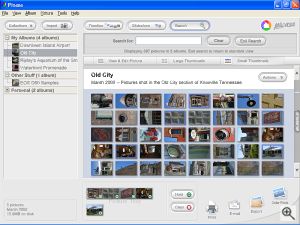
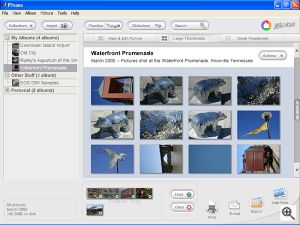
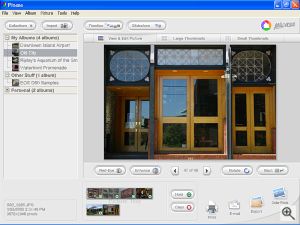
Sharp-eyed viewers will notice a search function in the first screenshot above. The functionality of this search doesn't currently make the program well-suited to dealing with very large photo collections, as it allows the user only to search for words in album titles and descriptions. However, in talking to the company at last night's Digital Focus press event, we were told that captions for individual photos will be possible in an update which should be released in December. This is a significant change which will greatly expand the program's capabilities, and make it more appropriate for managing your photo collection. Where Picasa really shines is in its very nicely designed photo sharing functions. A slideshow mode is coupled with what Lifescape calls a "timeline" - somewhat similar to a feature from Canon's ZoomBrowser software, although instead of being able to scroll through your individual photos by the time they were taken, you scroll through entire albums by date. The slideshow can either be manually controlled with a small toolbar at the bottom of the screen, or set to automatically change photos every few seconds. Two nice visual touches are the "fade" transition between images in an automatic slideshow, and the way the timeline uses an image from each album as a stylish looking backdrop whilst you choose an album. A few more transition types for the slideshow might be a nice addition to a future version, but all in all we're very impressed with this portion of the program. 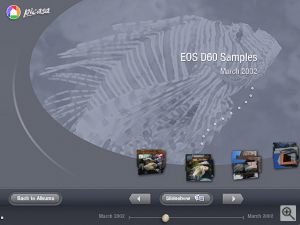
Note that we encountered a minor bug in the software in the timeline and slideshow, which Lifescape is currently working on solving. On certain graphics cards - apparently including the ATI Rage Mobility M1 AGP in Mike's laptop - the timeline and slideshow (the latter only when in auto mode) are shown at VGA (640 x 480) resolution, rather than the computer's default resolution. This should hopefully be fixed soon, but in the meantime note that the low-resolution screenshot above is not indicative of the quality of this screen on most graphics cards. 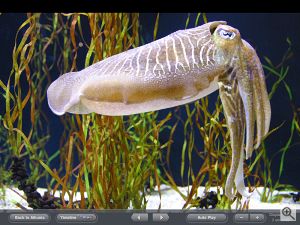
Sharing photos is a snap in Picasa. Simply select one or more images from your albums, and small thumbnails will appear in a holding area at the bottom of the screen. Click the 'hold' button, and you can select another batch of images without the first being dropped from this holding area. Once you've found all the images you want, a quick click of either the 'Print', 'E-mail', 'Export' or 'Order Prints' buttons will take you to the relevant portion of the program. The 'Print' button brings up a new screen (below) where you can choose to print a full-page print, 4" x 6" prints (two per page), 3.5" x 5" prints (four per page), or contact sheets with up to 42 thumbnails per page. You can also choose whether to crop your images top and bottom, or add borders left and right to make them match the aspect ratio of the standard print sizes. Duplicate prints can be made by clicking 'plus' and 'minus' buttons, and you can select and setup your printer. Finally, you can opt for standard mode ("Good quality, compatible with most printers' resolutions, especially HP.") or optimised mode ("Highest quality, uses your printer's resolution. Test on inexpensive paper first.") We've not had a chance to test the print quality achieved by Picasa (Mike's actually writing this article from the press room at Comdex) but the interface is certainly friendly and simple for a beginner to understand. 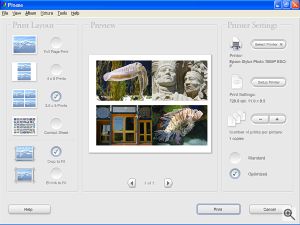
The 'E-mail' button gives you two choices - to send your images via Microsoft Outlook, or through Picasa's own email routine. Your selection can be saved and the question skipped in future if you choose. Images are resized and recompressed automatically for you, and attached to a blank email. The size and compression ratio are not currently user adjustable, but again in talking to Lifescape reps we learned that they're planning to add some user control over this process. The 'Export' button simply allows you to make duplicates of the images you selected, either in their original resolution or resized to 320, 640 or 1024 pixels wide in a new folder on your PC. Finally, the 'Order Prints' button is self-explanatory - click on it, and your images are automatically uploaded to Lifescape, and you can then choose print sizes and quantities for delivery by mail. We've not attempted to test this portion of the program as yet. Unlike some competing programs which we mentioned recently, Picasa is not being offered free through co-branding or print revenues, but is instead available at a cost of $29.99. For a first incarnation, the result is fairly impressive - the program has a very clean, attractive interface and is simple to learn and use. Equally impressive is the company's commitment to making the program even better. In talking with company reps, we mentioned a number of small points that we'd like to see changed, and were told that the next release to be available as a free upgrade in December will address these issues. In fact, on several points Lifescape staff told us that features were to be added before we'd even asked about them - the company is obviously listening closely to customers and reviewers, and working to satisfy their requests. As well as the planned updates already mentioned in this item, features such as compatibility with a wider range of graphics formats (including MPEG video) and more are on the way... There's getting to be quite a lot of competition amongst software vendors to offer a digital equivalent of the shoebox that you likely stored your film prints in, and with a little more development to extend the functionality slightly, we have no doubt that Lifescape will have a worthy challenger on their hands.
|
Original Source Press Release:
| PICASA GIVES DIGITAL PHOTOS A NEW HOME NEW AUTOMATIC PHOTO ORGANIZER LOCATES PICTURES STORED ON COMPUTERS, MAKES VIEWING, E-MAILING, PRINTING A SNAP
FRESH DESIGN APPROACH REFLECTS HUMAN FACTORS - PICASA THINKS LIKE PEOPLE THINK
BOSTON, Mass., October 15, 2002-Lifescape Solutions, Inc., noted for its mission "to bring fresh, compelling digital imaging products to mainstream consumers," today released Picasa, a new, intuitively easy-to-use software package created to help digital photographers effortlessly manage the family photo collection and enhance the enjoyment of reliving and sharing photo memories.
"The best home for your pictures," Picasa has been designed for the growing number of digital photographers currently frustrated by the arcane filing systems and multi-step processes used by most digital imaging programs, and who simply want to take, see, organize, share and enjoy their growing digital photo collections.
"Picasa is the first step by our company on our mission to create digital imaging products that are perfectly aligned with consumer lifestyle needs and are effortless to use," states Lars Perkins, Lifescape's chief executive officer.
"Picasa's ability to find and display images quickly and dramatically, requiring no special skills by the user except the desire to take, view, organize and enjoy a family's valuable and growing collection of digital memories, makes it the perfect companion to today's digital cameras."
DESIGNED FOR "REAL PEOPLE"
Lifescape designed its new Picasa by taking a fresh and innovative approach to digital imaging software. Picasa is based on studied insights into human cognitive preferences and memory schemata to create an intuitive, highly-visual program that self-organizes digital images. Picasa allows users to find pictures instantly by browsing through a digital photo archive and eliminates the need to recall file names, folder names or directory paths.
According to Lifescape Solutions President Ed Chao, Picasa is a "blend of visual and mental ergonomics reflective of human behavior patterns. It is the result of more than two years' observation into how 'real' people use digital cameras and their home computers to view and share family photos.
"Picasa emphasizes a visual interactive interface based on the human dominant sense of sight and our natural preference for spatial memory-emulating how drivers remember where they parked or how to get to the mall without recalling street names or specific directions given in decimal points of a mile.
"Picasa was created primarily for families, especially the family's 'memory manager' who prefers not to wrestle with multiple computer programs and files to enjoy the family album or, even worse, worry about losing valuable pictures somewhere on the computer's hard drive," says Chao.
PHOTOS INSTANTLY ORGANIZED AND PRESENTED IN HOME THEATER-LIKE 3-D "TIMELINE"
Upon installation, Picasa automatically ferrets out, finds and displays all photos lurking inside all the directories on a computer's hard disk, displays them in mini-albums and arranges them by date. It then presents each mini-album ready for viewing as a slideshow or in an innovative, kinetic "Timeline"- an interactive innovation Lifescape compares to a form of home theater. "It's intriguing, entertaining and fun," states Chao.
"Photographs are vital icons, representative of important events and people in one's life. We have observed in our studies that people do not necessarily elect to revisit individual photographs but are primarily motivated to relive certain events, usually very special events. By grouping pictures and presenting them as events, Picasa's Timeline provides an inviting pathway for time-traveling through photographic memories.
"It's an enjoyable and, above all, rewarding feel-good experience," adds Chao.
"Our research indicates that most people naturally prefer to organize their memories by time," states Chao. "We all remember events visually in our mind's eye."
EFFORTLESS E-MAIL AND PHOTO PRINTING
While Picasa's most distinctive attribute is its ability to make a family album of digital pictures or an individual photo instantly accessible, Picasa also makes transferring pictures into a computer and sharing pictures by e-mail effortless.
When a USB-enabled camera is connected to a computer, Picasa's photo-importing process starts automatically. Sharing pictures by e-mail is as simple as selecting the pictures and clicking Picasa's e-mail icon.
"Its like sitting at the table, with all your pictures spread out in front of you," says Chao. "Picasa lets you spontaneously set a few treasured photos aside to e-mail to family and friends."
Picasa also provides easy interface to desktop printers and professional photo-processing laboratories for high quality prints. "This feature was created in response to our study groups' concerns claiming printing was 'too complicated,'" says Chao.
For desktop printing, Picasa presents a preview page of the photograph to be printed- avoiding what Chao calls "guessing games" with printer dialog boxes and avoiding misprinted photos on expensive photographic paper.
MORE ENJOYABLE, EASIER, REWARDING AND "FRICTION-FREE"
"All in all, we believe Picasa's fresh approach program makes digital photography simply more enjoyable, easier and rewarding," adds Chao.
"Our beta-test trial users have universally changed the way they interact with their photographs. Picasa has made digital photography so friction-free that users enjoy viewing their collections more frequently, and are not thinking twice about making prints to send to Grandma. With Picasa, digital photos are no longer mere fleeting, transient phosphors, but real and vital pictures to pass on to others, and to future generations."
Picasa is scheduled to be available in November at leading mass merchant outlets, software and photographic retailers at a suggested list price of $29.99. A full-featured trial version of Picasa and additional information is available at www.picasa.net.
Lifescape studies predict that, by early 2003, more than 25 percent of U.S households will own a digital camera.
### |
Powered by Coranto
|